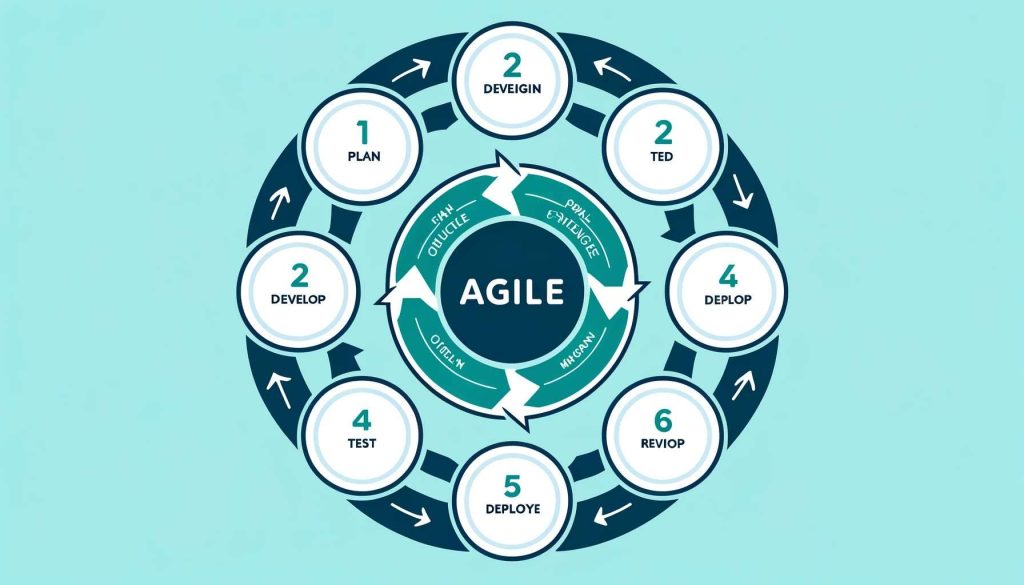Last updated on May 20th, 2024 at 06:11 pm
Agile methodology is a popular approach to project management that emphasizes flexibility, collaboration, and iterative development. In contrast to traditional waterfall methods, Agile focuses on delivering working software in short, incremental batches called sprints. This facilitates rapid adaptation of teams to changing requirements and feedback, leading to a more customer-focused approach. Here we will discuss phases of Agile development and take a look at which projects use Agile methodology.
Phases of Agile Development
The following is a brief description of each of the phases typically involved in agile projects:

Plan
This initial phase involves defining the project scope, identifying the key requirements, and planning the overall project timeline. The goal is to outline the project’s objectives and prepare a roadmap for the iterations to come.
Design
During this phase, the team works on the design aspects of the project, including architecture, user interfaces, and other critical design decisions. The design phase ensures that the technical and aesthetic aspects of the project align with user needs and project goals.
Develop
This is the execution phase where the actual development of the software takes place. When developing within the agile method, we break it down to small incremental steps called “sprints,” for up to four weeks where special features or parts of a project are developed, integrated and ready for testing.
Test
Testing in Agile is usually integrated throughout the development process rather than being a distinct phase at the end. This phase involves continuous testing of the developed features to identify bugs and ensure that the software meets the required standards and functionalities.
Deploy
Once the features are developed and tested, they are deployed into a production environment where they can be used by end-users. In Agile, deployment can be frequent and incremental to ensure that users benefit from continuous improvements and updates.
Review
After deployment, the team reviews the outcomes, gathers feedback from stakeholders, and evaluates the project’s progress. This review helps in understanding what worked well and what needs improvement. Insights gained from this phase are used to plan the next iteration, making adjustments based on the feedback.
Which projects use Agile methodology?
The answer is any project that values adaptability, collaboration, and continuous improvement as key drivers of success.
A flexible and efficient method of project management, agile methodology can benefit a wide range of projects from software development to marketing campaigns for research and development. Teams can achieve greater flexibility, efficiency and collaboration through the adoption of agile principles that contribute to success and deliver value for those involved.
Real-life examples of Agile Methodology
Software Development
- Sprint Planning: Agile teams in software development often use sprint planning meetings to define the scope of work for the upcoming sprint. This allows team members to collaborate, prioritize tasks, and set achievable goals for the iteration.
- Daily Stand-up Meetings: Daily stand-up meetings, also known as daily scrum meetings, are a common practice in Agile software development. Team members gather to discuss progress and roadblocks and plan their tasks for the day.
- Iterative Development: Agile promotes iterative development, where software is built incrementally in small, manageable chunks. This allows for faster feedback loops, making it easier to adapt to changing requirements.
Agile in Marketing
- Agile Marketing Campaigns: Marketers can apply Agile principles to their campaigns by breaking down large projects into smaller tasks, setting short deadlines, and continuously evaluating and adjusting their strategies based on data and feedback.
- Cross-functional Teams: Agile encourages collaboration among cross-functional teams, bringing together individuals with diverse skill sets to work towards common goals. This can help improve communication and efficiency in marketing campaigns.
Project Management
- Kanban Boards: Agile project managers often use Kanban boards to visualize workflow, track progress, and identify bottlenecks in the project. This visual tool allows team members to see the status of tasks at a glance.
- Retrospective Meetings: After each iteration, Agile project teams hold retrospective meetings to reflect on what went well, what could be improved, and what actions can be taken to enhance future performance. This continuous feedback loop helps teams learn and grow.
Agile in Customer Service
- Customer Feedback Loops: Agile customer service teams leverage customer feedback to improve processes and services. By collecting customer input regularly and making adjustments based on that feedback, teams can deliver better customer experiences.
- Adaptive Service Delivery: Agile customer service embraces change and is quick to adapt to evolving customer needs. Service teams prioritize customer satisfaction and strive to provide solutions in a timely and efficient manner.
Conclusion
At the last, the agile methodology is a powerful tool that can help companies to manage complex project management processes. You can unlock the potential of this methodology and turn it into a success story if you understand when to apply an agile methodology and how to align it with your project’s specific needs. The agile methodology offers a flexible and collaborative approach to achieving your objectives, whether you have vague requirements, complex projects, or time-sensitive deliverables.

















Leave a Reply